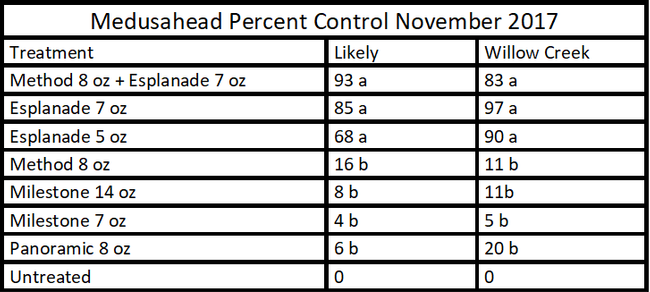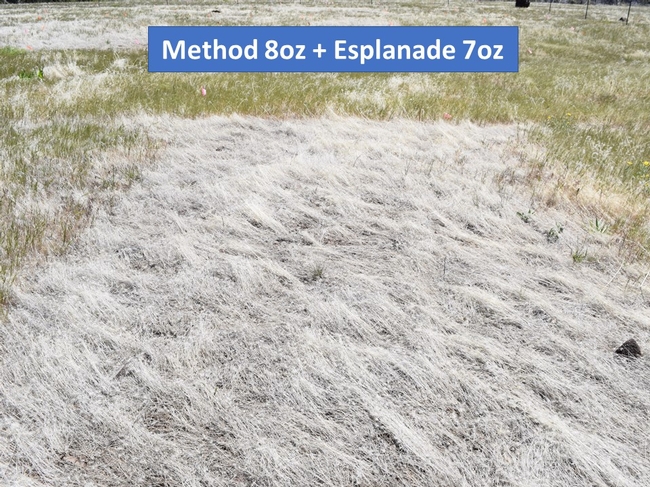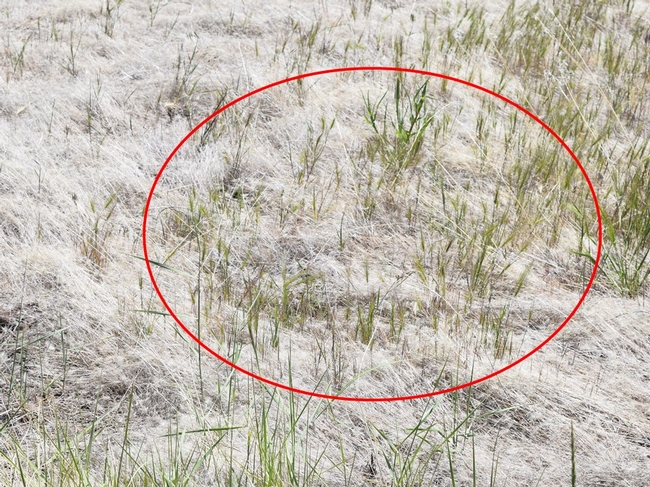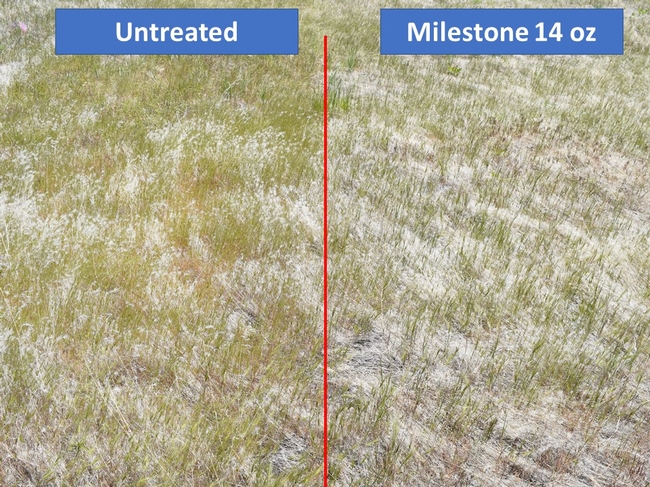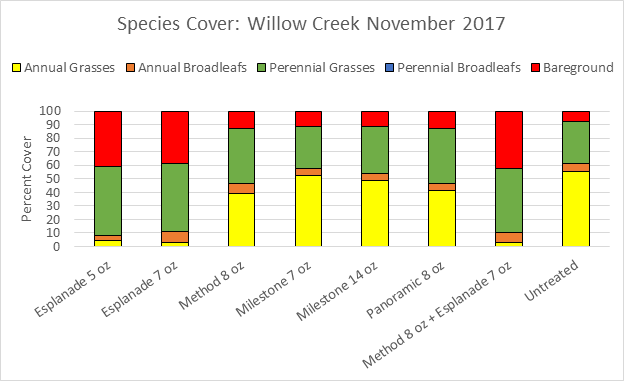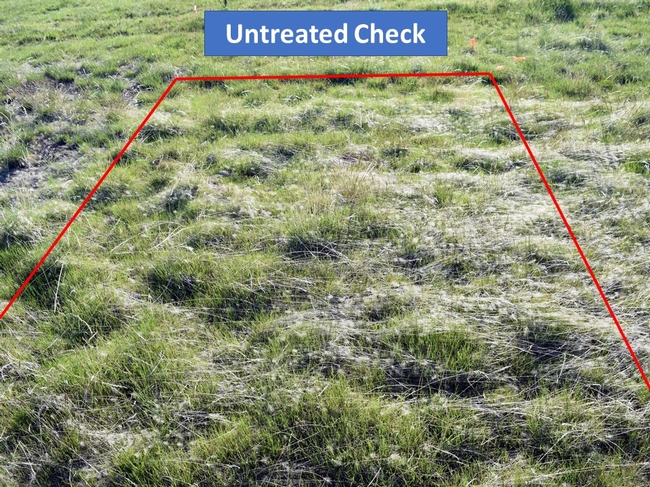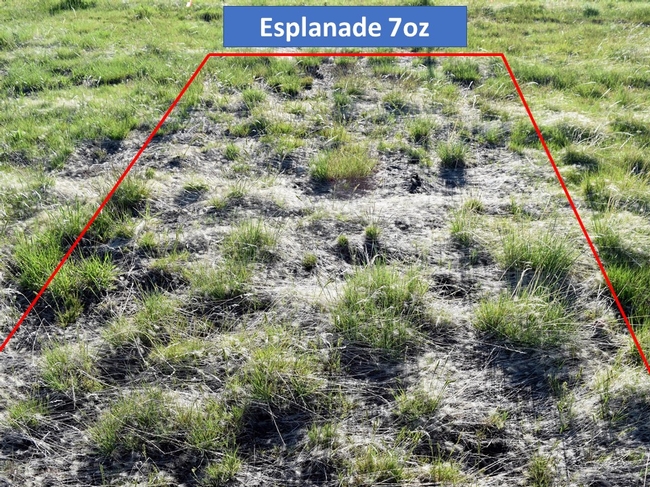Last year about this time, I posted a blog regarding an ongoing trial investigating various herbicides for Pre-emergent Control of Medusahead. I wanted to follow up on that trial which I “deemed” unsuccessful and share some of the data collected in 2017.
The main objective of the study was to test various herbicides for medusahead control. I was interested if some of the work conducted at Colorado State with Esplanade (indaziflam) could be replicated with medusahead. In Colorado field trials, single applications of Esplanade had offered three-year control of cheatgrass without litter manipulation prior to application. Could this be replicated with medusahead, notorious for its thick persistent litter layer? Secondly, it was of interest to take a look at Milestone (aminopyralid) applications as a preemergence treatment in the Intermountain Region. Josh Davy, Guy Kyser and Joe DiTomaso had seen excellent success utilizing Milestone for preemergent medusahead control in lower elevation rangelands, as indicated in one of Dr. DiTomaso Blogs and this article from Techline Invasive Plant News.
I implemented two field trials in September of 2016 to investigate if single applications of either of these products could be effective for medusahead control. At the time of application, no medusahead had germinated, so the preemergent activity for each of these products was being tested. One trial was located by Willow Creek near Goose Lake, and the other trial was located further south, just outside of Likely, California.
While initial results from the evaluation in November of 2016 were not great, I wanted to continue to follow the plots. Further evaluations were conducted in June and November of 2017 at both trial locations. Results from both sites at the November 2017 evaluation can be found in Table One below:
Table One: Displays percent medusahead control at both sites in November 2017, 14 months after treatment.
Good control of medusahead was achieved at both study sites in most treatments that contained Esplanade. At the Willow Creek site, Esplanade 7oz/acre alone offered 97 percent control. Where the best treatment at the Likely site was a combination of Method 8oz + Esplanade 7oz/acre which gave 92 percent control (Picture one). Looking at the plots anecdotally, it appeared Esplanade failed to control the medusahead in areas where litter layers were the thickest (Picture two). Milestone 14 oz/acre offered some suppression of medusahead at both sites during the June evaluation (Picture Three), however, almost no control was observed in germinating seedlings during the November 2017 assessments. Panoramic (imazapic) was unsuccessful at both sites.
Picture One: Excellent control of medusahead at the Likely site for the June evaluation of Method 8 oz + Esplanade 7 oz in this replication. Some small perennial grasses are present in the top right corner of the plot, but overall medusahead was largely replaced with bare ground (litter from the previous year).
Picture two: The Likely site in June of 2017 looking at the 7 oz Esplanade treatment. The red circle highlights where medusahead grew through the treatment. Outside of the circle, excellent control was observed and the litter layer from the previous growing season still covered the soil surface. Some perennial grasses are present.
Picture Three: The Likely site in June of 2017, looking down the middle of an untreated check and Milestone at 14 oz. At this evaluation, Milestone offered some suppression of the medusahead. However, by the fall evaluation, medusahead not initially controlled by Milestone took advantage of the lower densities, and individual plants grew much larger and more vigorously than individual plants in the untreated control.
These field trials have certainly seen an interesting set of environmental conditions as one of the wettest winters in recorded history came after application. All of the precipitation certainly could have affected the movement and degradation of herbicides applied. It could be considered a worst case scenario, or a best case scenario to test the effectiveness of the residual activity these products have.
There were populations of perennial grasses at each site with larger populations existing at the Willow Creek site. An assessment of species cover by functional group was conducted, and Table Two displays the results for the Willow Creek site in November 2017. Largely reductions in medusahead were replaced with bare ground, along with small numerical increases in perennial grass cover. Similar results were seen at the Likely site, but perennial grass populations were much lower and more sporadic throughout the plots.
Table Two: Species cover by functional class for the Willow Creek site for the November 2017 site evaluation.
Picture Four: The untreated check for the June assessment at the Willow Creek site. Medusahead was vigorously growing in-between the interspaces of perennial grass species.
Picture Five: Willow Creek, Esplanade 7oz at the June assessment. No medusahead was recorded in this plot. Actively growing grasses are perennial species. Medusahead litter from the previous growing season can be observed in the interspaces of the perennial grasses.
Esplanade has a very long residual activity, and I am planning on monitoring these studies throughout the 2018 growing season. It will be interesting to see if some of the bare ground previously occupied by medusahead will fill in with other species, or if it will refill with medusahead. When resources allow, I would like to re-test both Esplanade and Milestone under different environmental conditions. Please feel free to follow up with me if you have any questions: tjgetts@ucanr.edu.
